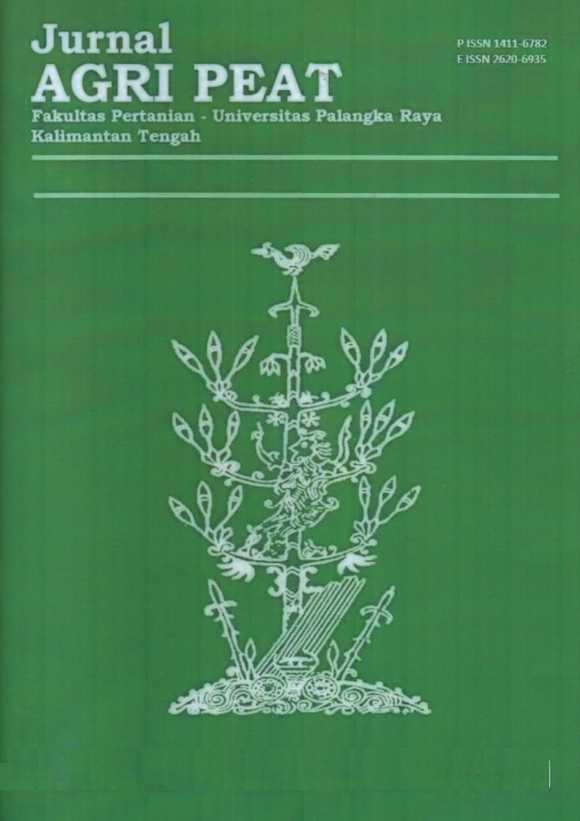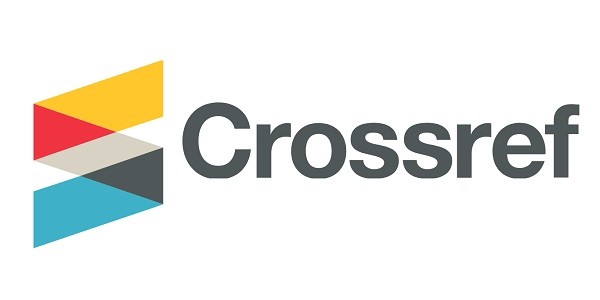RESPON PERTUMBUHAN DAN HASIL KEDELAI (Glycine max (L) Merril GALUR GH-63 YANG DIBERI PUPUK HAYATI PADA GAMBUT PEDALAMAN
GROWTH AND YIELD RESPONSE OF SOYBEAN (Glycine max (L) Merril GH-63 STRAINS GIVEN BIOLOGICAL FERTILIZER ON INLAND PEAT
DOI:
https://doi.org/10.36873/agp.v26i02.19735Keywords:
biofertilizer, soybean GH-63 strains, inland peatAbstract
The purpose of this study was to study the effect of organic fertilizer on the growth and yield of GH-63 soybeans on inland peat. The peat used was taken from Kalampangan Village and the land conditions had never been used for agricultural cultivation. The study was conducted in the Peat Techno Park area of Palangka Raya University. Using a Completely Randomized Design, with 4 treatments of Rhizoka compound organic fertilizer dosage, namely H0 = 0 g.kg seed-1, H1 = 10 g.kg seed-1, H2 = 20 g.kg seed-1, H3 = 30 g.kg seed-1. Each treatment was repeated 5 times and because there were destructive and non destructive observations, the study was conducted in 2 (two) equal series. Data were analyzed by analysis of variance at the 5% and 1% levels. If the results of the analysis of variance indicate a significant effect, it is continued with the BNJ test at the 5% level. The results showed that treatment H3 = 30 g.kg seed-1 as the best treatment in all parameters, namely leaf area (77.03 cm2), effective root nodule weight (1.015 g), root dry weight (1.04 g), loss dry weight (3.71 g), root extinction ratio (3.64 g), number of seeds (1.98 seeds) and seed weight (1.15 g) compared H0 = 0 g.kg seed-1. The dose dose of biofertilizer is 30 g.kg seed-1 as the best dose for the growth and yield of GH-63 soybean plants on inland peat.
Downloads
References
Anda, M., Ritung, S., Suryani, E., Sukarman, Hikmat, M., Yatno, E., Mulyani, A., Subandiono, R. E., Suratman, & Husnain. 2021. Revisiting tropical peatlands in Indonesia: Semi-detailed mapping, extent and depth distribution assessment. Geoderma, 402, 115235. https://doi.org/10.1016/j.geoderma.2021.115235
Badan Pusat Statistik. 2023. Data Impor Kedelai Menurut Negara Asal Utama, 2010 - 2023. Data Terakhir Diperbaharui 24 Sepetember 2024
Bachtiar, T., & Waluyo, S. H. 2013. Effect of Biofertilizer on Growth and Nitrogen Uptake of Soybean Plants (Glycine max . L .) Varieties Mitani and Anjasmoro. Widyariset, 16(3).
Chotimah, H. E. N. C., Zubaidah, S., Syahrudin, Darung, U., Asie, K. V., Purba, B. S., & Ichriani, G. I. 2024. Growth, Yield and Seed Nutrient Quality of Soybean Grown in Inland Peatland as Affected by Cow Manure Application. International Journal of Design & Nature and Ecodynamics, 19(1), 221–228. https://doi.org/10.18280/ijdne.190124
Domsch, K. H. 1980. Soil microorganisms and plants. Agro-Ecosystems, 6(1), 85. https://doi.org/10.1016/0304-3746(80)90007-4
Frasca, L. L. de M., Nascente, A. S., Rezende, C. C., Silva, M. A., Lanna, A. C., Ferreira, E. P. de B., & Duarte, J. R. de M. 2023. Consortium of multifunctional microorganisms in soybean culture. Colloqium Agrariae, 18(4), 61–67. https://doi.org/10.5747/ca.2022.v18.n4.a508
Gao, Y., Li, X., Shen, X., Sun, J., & Duan, A. 2015. Soil respiration and nitrification– denitrification in maize/soybean intercropping system. Oxidation Communications, 38(1A).
Giraud, E., & Fleischman, D. 2004. Nitrogen-fixing symbiosis between photosynthetic bacteria and legumes. Photosynthesis Research, 82(2), 115–130. https://doi.org/10.1007/s11120-004-1768-1
Hasanah, Y., Hanum, H., Harahap, N. A., & Harahap, A. S. 2024. Role of Molybdenum in Relationship with Rhizobium sp. and its Effect on Physiological Characteristics and Soybean Production. Asian Journal of Plant Sciences, 23(1), 54–60. https://doi.org/10.3923/ajps.2024.54.60
Hasanah, Y., Nisa, T. C., Hapsoh, & Hanum, H. 2018. Physiological characters of soybean cultivars with application of nitrogen sources under dry land conditions. IOP Conference Series: Earth and Environmental Science, 122(1), 012055. https://doi.org/10.1088/1755-1315/122/1/012055
Karapetyan, A. 2022. Assessment of physicochemical characteristics of biofertilizers and their role in the rooting capacity of plants. Agronomía Colombiana, 40(2). https://doi.org/10.15446/agron.colomb.v40n2.100425
Neneng, L. 2020. Formulation of Liquid Biofertilizer for Enhance of Soil Nutrients in Peatland. Budapest International Research in Exact Sciences (BirEx) Journal, 2(3).
Prakash, R. K., & Atherly, A. G. 1986. Plasmids of Rhizobium and Their Role in Symbiotic Nitrogen Fixation. In International Review of Cytology (Vol. 104, Issue C, pp. 1–24). https://doi.org/10.1016/S0074-7696(08)61921-X
Prihtanti, T. M. 2023. Feasibility of Soybean Farming in Indonesia: A Systemic Literature Review. Agric, 35(2). https://doi.org/10.24246/agric.2023.v35.i2.p329-344
Saha, S., Paul, D., Poudel, T. R., Basunia, N. M., Hasan, T., Hasan, M., Li, B., Reza, R., Haque, A. R., Hanif, M. A., Sarker, M., Roberts, N. J., Khoso, M. A., Wu, H., & Shen, H. 2023. Biofertilizer science and practice for agriculture and forestry: A review. Journal of Applied Biology & Biotechnology, 11(6). https://doi.org/10.7324/JABB.2023.148741
Sari, W. P., Adriani, D. E., & Nisa, C. 2021. Growth Response of Edamame Soybean (Glycine max (L.) Merr.) with Application of Urea and Rhizobium Biofertilizer on Peat Soil Media. Tropical Wetland Journal, 7(1). https://doi.org/10.20527/twj.v7i1.100
Sasongko, S. R., Utami, S. N. H., & Purwanto, B. H. 2019. Effects of NPK and mycorrhizae on the growth, P uptake of soybean, and soil chemist in peatland, Pelalawan, Riau. IOP Conference Series: Earth and Environmental Science, 393(1), 012003. https://doi.org/10.1088/1755-1315/393/1/012003
Setiawati, M. R., Safitri, E., Indrayani, S. N., Fatimah, E. E., Qurnia, N. F., Hindersah, R., & Suryatmana, P. 2021. Perbedaan Konsentrasi Pupuk Hayati Cair Berbasis Azolla terhadap Pertumbuhan dan Hasil Tanaman Pakcoy (Brassica rapa L.). Jurnal Agroekoteknologi, 13(2). https://doi.org/10.33512/jur.agroekotetek.v13i2.13161
Tabrani, G., Dini, I. R., & Purnomo, H. S. 2023. Effectiveness of indigenous Rhizobium sp. isolates from peatland soils on soybean (Glycine max L. Merril) growth and production. Jurnal Ilmiah Pertanian, 20(2). https://doi.org/10.31849/jip.v20i2.10909
Tang, J., Li, Y., Zhang, L., Mu, J., Jiang, Y., Fu, H., Zhang, Y., Cui, H., Yu, X., & Ye, Z. 2023. Biosynthetic Pathways and Functions of Indole-3-Acetic Acid in Microorganisms. In Microorganisms (Vol. 11, Issue 8). https://doi.org/10.3390/microorganisms11082077
Yarwood, S. A. 2021. Microbial ecology. In Principles and Applications of Soil Microbiology (pp. 239–267). Elsevier. https://doi.org/10.1016/B978-0-12-820202-9.00010-1
Downloads
Published
Issue
Section
License
Copyright (c) 2025 AgriPeat

This work is licensed under a Creative Commons Attribution-NonCommercial-ShareAlike 4.0 International License.












